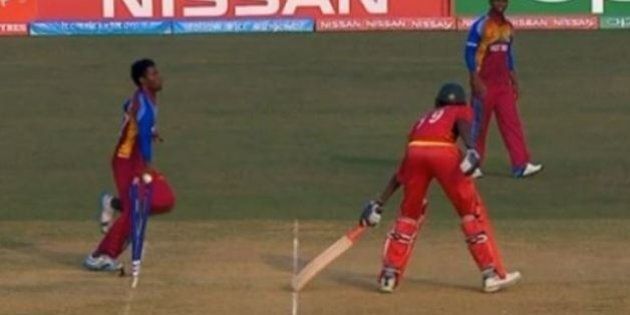
Things got really ugly at the cricket Under-19 World Cup overnight, when the West Indies beat Zimbabwe in the last over with a rare "mankad" dismissal.
Named for Indian bowler Vinoo Mankad who pulled the trick in Australia way back in 1947, the mankad is when a bowler runs out the batsman at the non-striker's end, by breaking the stumps as he runs in to bowl.
It's actually a legal move which is designed to prevent the non-striker getting a headstart as he takes off for a run. But cricket etiquette dictates that the bowler warns the batsman or umpire first.
Mankad himself did not do this in 1947, and nor did West Indies bowler Keemo Paul in 2016 as he ran out Zimbabwe's Richard Ngarava.
It was the final over of a tense match. Three runs were needed.
The dismissal ended the match and sent a jubilant West Indies into the quarter finals, prompting outrage from assorted cricket big fish.
Like Gilly.
And Boof.
And a bunch of other people known mostly by their one-word nicknames.
Much like the underarm ball 35 years ago, a mankad dismissal falls within the rules of cricket but definitely not within the spirit. That's why people are so angry. The bowler in this case never even got into his bowling stride, but clearly ran in with the express purpose of mankading the non-striker. Did he warn the batsman? He did not. Bad form, mate.
But there's another side to this story. Some cynical batsmen often steal ground without fear when they're at the non-striker's end. Bowlers and umpires are often too busy to notice or to take action. The rule is there to stop batsmen taking the piss, and most cricket fans want it enforced.
This sentiment is reflected on the website ESPNcricinfo, where a poll which asks whether the mankad dismissal should be part of the game currently has the following results after more than 20,000 reponses.
- Yes - the batsman should not be allowed to gain ground unfairly 37.15%
- No - it is not within the spirit of the game 13.43%
- Yes - but only after the batsman has been warned once 49.42%
Roughly 87 percent of fans say the mankad should be allowed. Some want a warning first, others don't. But there's a message to both batsmen and bowlers here. Batsmen, stop bending the rules. Bowlers, don't let them (but try to do so nicely).
Some cricket types have put it more bluntly than that:
Indian commentator and former player Sanjay Manjrekar, who is covering the Under-19 World Cup, said: "I think mankading should be looked at like any other dismissal. The batsman should not be leaving the crease before the ball is released. Simple. If he does he pays the price for it. Not the bowler's fault."
Interestingly, the greatest cricketer of all time Don Bradman, played in the 1947 mankad Test. Here's what he wrote about the incident in his autobiography:
"For the life of me, I can't understand why [people] questioned his sportsmanship. The laws of cricket make it quite clear that the non-striker must keep within his ground until the ball has been delivered. If not, why is the provision there which enables the bowler to run him out? By backing up too far or too early, the non-striker is very obviously gaining an unfair advantage."
For the record, karma had the last laugh in that 1947 Test. Opening batsman Vinoo Mankad was dismissed for a paltry 5 in both innings. He was bowled in both innings, the great Australian quick Ray Lindwall breaking his stumps from 22 yards rather than point blank.